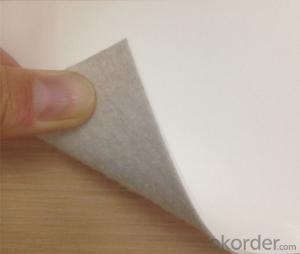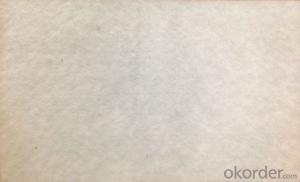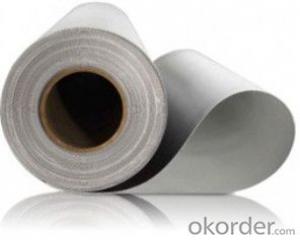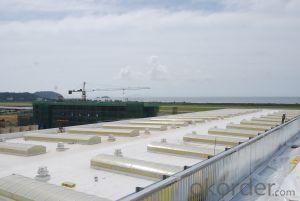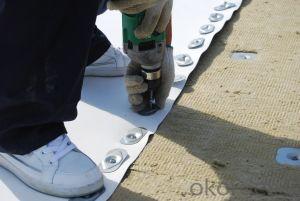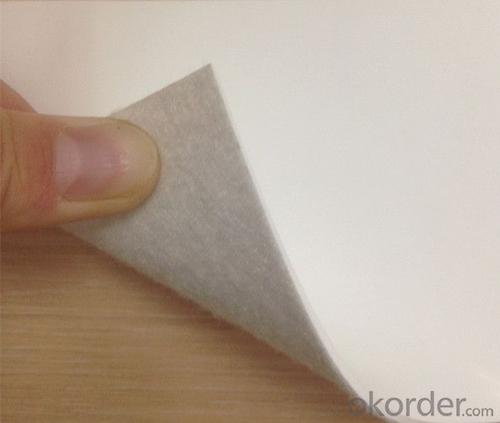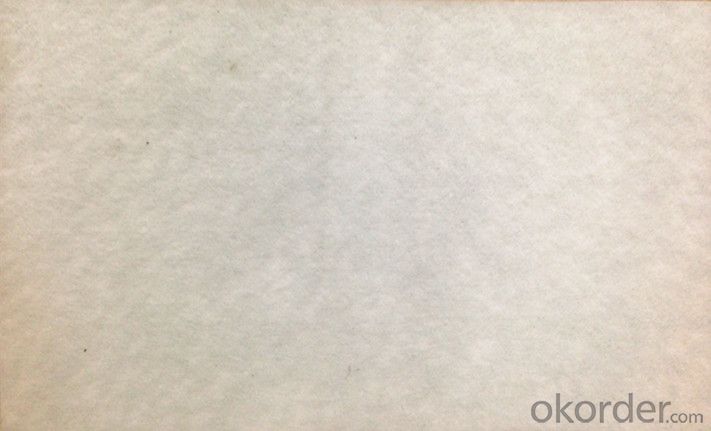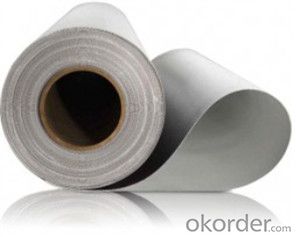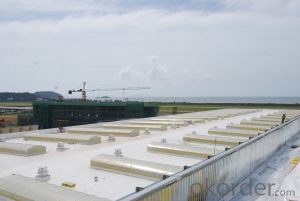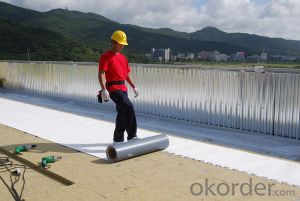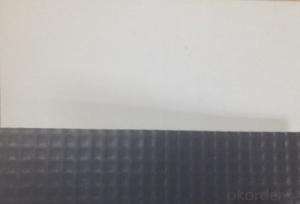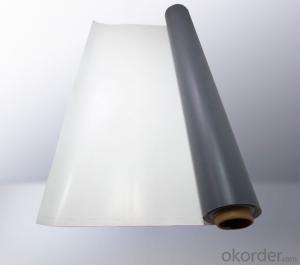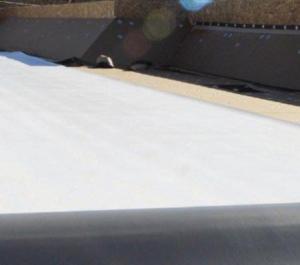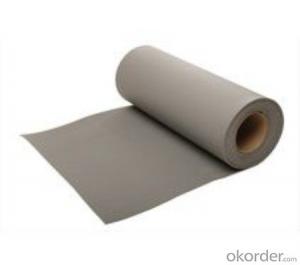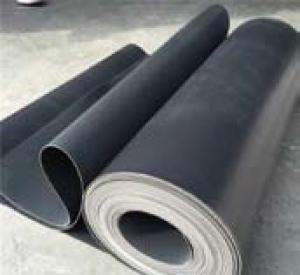TPO Waterproof Membrane with Polyester Fleece Backing
- Loading Port:
- Shanghai
- Payment Terms:
- TT or LC
- Min Order Qty:
- 4000 m²
- Supply Capability:
- 400000 m²/month
OKorder Service Pledge
OKorder Financial Service
You Might Also Like
TPO Waterproof Membrane with Polyester Fleece Backing
Product Profle
TPO membrane is a flexible Thermoplastic Polyolefin (FPO) roofing membrane made from the incorporation of a ethylene propylene rubber into a polypropylene matrix. The membrane is specifically formulated for long-term weather resistance without plasticizers.
We produce 4 types of TPO membrane to satisfy all the needs of different applications.
1.Polyester Fleece Backing Thermoplastic Polyolefin Waterproof Membrane
2.Polyester Mesh Reinforced Thermoplastic Polyolefin Waterproof Membrane
3. Homogeneous Thermoplastic Polyolefin Waterproof Membrane
4. Self adhesive TPO Membrane
TPO Waterproof Membrane with Polyester Fleece Backing is a waterproof sheet, consisting of thermoplastic polyolefin compound resin materials as the base stock, reinforced with fiber backing materials. There have two kinds of thickness: 1.2mm and 1.5mm.
Advantages
● Weather resistance and durability;
● Excellent weld ability;
● No any crisp agents to prevent materials brittleness;
● Intermediate enhanced polyester mesh fabric to have high tensile strength, fatigue resistance and penetrating resistance suitable for mechanically attached roofing systems;
● Excellent the same high and low temperature resistance as rubber materials which can keep flexible at -50° C and keep mechanical strength in high temperature;
● Excellent chemical resistance to acids, bases, and restaurant exhaust emissions;
● Dimension stability;
● White-based light-color and smooth surface with high reflection, energy saving and anti-dust functions;
● Use heat welding for the seam areas to form a reliable seamless waterproof layer.
● Available in more than 9 colors.
Applications
-Various roofing waterproof projects, such as industrial and civil buildings, public constructions
- Full adhered system for concrete substrate or mechanically attached systems.
Propoties
Item | Requirement | Test Method | ||
Thickness, min, mm | Sheet-overall | ≥1.0 | ASTM D6878 | |
Coating over fabric or scrim, weathering side only | ≥0.305 | ASTM D751 | ||
Breaking strength, min, N | ≥976 | ASTM D751 | ||
Elongation at reinforcement break, min, % | ≥15 | ASTM D751 | ||
Tensile strength,min, N | ≥245 | ASTM D751 | ||
Brittleness point, max, °C | ≤-40 | ASTM D2137 | ||
Ozone resistance | no cracks | ASTM D1149 | ||
Properties after heat aging | Breaking strength, % min | ≥90 | ASTM D573 | |
Elongation at reinforcement break, % min | ≥90 | ASTM D573 | ||
Tearing strength, % min | ≥60 | ASTM D573 | ||
Weight change (mass), max % | ≤±1 | ASTM D573 | ||
Linear dimensional change, max, % | ≤±1 | ASTM D1204 | ||
Water absorption, max, mass % | ≤±3.0 | ASTM D471 | ||
Factory seam strength, min, N | ≥290 | ASTM D751 | ||
Weather resistance | Visual inspection | - | ||
Packaging
Thickness | Roll Size | Rolls / Wooden Crate | Wooden Crate / 20’ Container |
1.2 mm | 15 m2 | 25 | 20~25 |
20 m2 | 25 | ||
30 m2 | 25 | ||
1.5 mm | 15 m2 | 25 | |
20 m2 | 25 | ||
30 m2 | 20 |
Above quantities are indicative only. We can produce it according to your demands.
Storage
TPO material should be stored in well-ventilated place and avoid being exposed to the sun or rain. The temperature in stored places can not be higher than 45° C. It only can be put horizontally in five-level. It has to be avoided acid, alkali, oil and organic solvents. The shelf life is 1 year.
Transportation
TPO material should avoid inclination or lateral drift during transportation. When necessary, covering with felted fabric.
Application System
We not only provides TPO waterproofing membrane, but also dedicates to integrated roofing systems. TPO single ply roofing waterproof system includes mechanically attached roofing system, fully adhered roofing system and ballasted roofing system.
Application Methods
● For Mechanically Attached Roofing System
Before application, spread TPO membranes on substrate in advance. Install TPO membranes perpendicular to steel deck ribs on the substrate without distortions according to the flange. The overlapping width is 120 mm. The minimum overlapping distance of membrane short side direction is 50 mm. Fasteners are installed according to designed position. Hot-air welding is adopted for laps with 40 mm welding width.
● For Fully Adhered Roofing System
Before application, spread TPO membranes on substrate in advance. Install TPO membranes on the substrate without distortions according to the flange. The overlapping width should be more than 50 mm. Hot-air welding is adopted for laps with 40 mm welding width. Professional adhesives need to be used on both underside and substrate surfaces to adhere and maintain.
● For Ballasted Roofing System
Before application, spread TPO membranes on substrate in advance. Install TPO membranes on the substrate without distortions according to the flange. The overlapping width should be more than 50 mm. Hot-air welding is adopted for laps with 40 mm welding width.
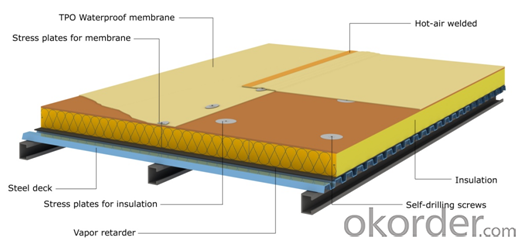
Attentions
● TPO membranes reflect heat and light, wearing protective clothing (long-sleeved shirt, long-barreled trousers), and wearing a filter to protect the skin and eyes from UV-induced damage.
● Security measures for roof perimeter are necessary when application. Sheet surface is slippery when wet, taking care to avoid slide.
● Sealants and adhesives are flammable containing solvents. They will be dangerous when exposure to heat, even have the possibility to catch fire and explode.
● Sealants, adhesives, cleaners should be avoided contacting with skin and eyes.
● No smoking during application.
FAQ
1. What’s your production ability of TPO membrane per year?
We own the largest EPDM production line in China. Our product ability of TPO membrane reaches 500million square meters.
2. How's your products quality?
Our TPO is with the top quality at home and abroad. Our quality is much higher than Chinese standard, they can satisfy the certification of CE, GOST-R, FM.
3. What's the service life of your TPO membrane?
The service life of our TPO membrane is more than 50 years.
4.What's your MOQ?
Our MOQ is 4000M2.
5. Can you provide free of charge samples for testing quality?
Yes, we’re very glad to send you free of charge samples for checking. You just need to pay for the freight cost.
6. How do you protect TPO membrane in transportation?
We package TPO rolls by PE bag, then 20~25 rolls will be packed into one big wooden crate.
7. Can you customize TPO membrane?
Yes, we’re very glad to customize TPO membrane according to your requirement. We can do more than 9 colors, and customize the thickness and width according to your requirement.
Photos
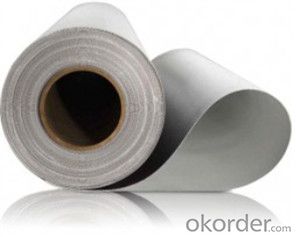

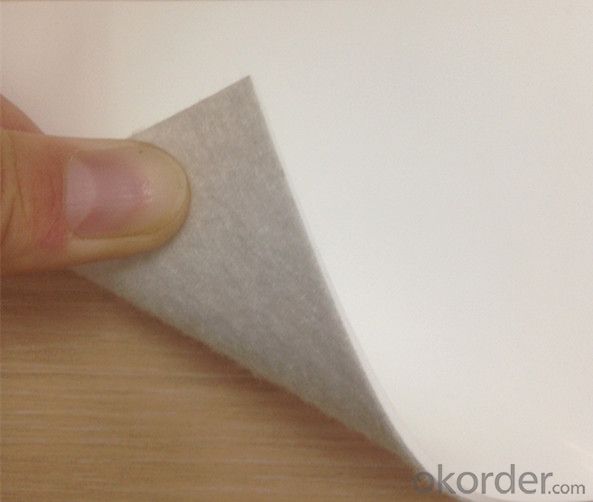
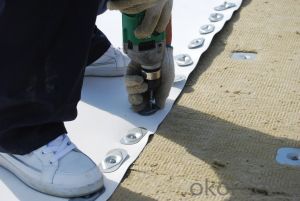
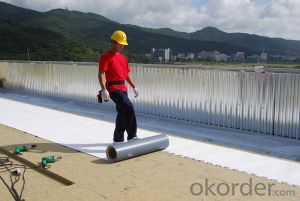

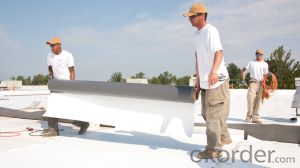
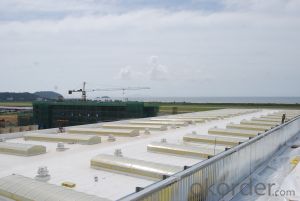
- Q: Can a waterproofing membrane be used on roofs with slope?
- Yes, a waterproofing membrane can be used on roofs with slope. In fact, it is often recommended to use a waterproofing membrane on sloped roofs to prevent water infiltration and to ensure proper drainage. The membrane is installed beneath the roofing material and acts as a barrier against moisture, helping to protect the roof and the underlying structure from water damage.
- Q: Are waterproofing membranes resistant to mineral oils?
- The resistance of waterproofing membranes to mineral oils can differ. Certain membranes are purposely engineered to withstand mineral oils, while others may not possess this capability. To ascertain the resistance level of a specific waterproofing membrane to mineral oils, it is crucial to review the manufacturer's specifications and product details. Moreover, seeking advice from a professional or directly contacting the manufacturer is advised to obtain tailored guidance regarding the compatibility of a waterproofing membrane with mineral oils in your unique scenario.
- Q: Can a waterproofing membrane be used on underground parking structures?
- Yes, a waterproofing membrane can be used on underground parking structures. In fact, it is highly recommended to have a waterproofing system in place to protect the structure from water ingress and potential damage. Underground parking structures are prone to water infiltration due to their below-ground level and close proximity to the water table. A waterproofing membrane acts as a barrier against water, preventing it from seeping into the structure and causing issues such as deterioration, corrosion, and mold growth. It helps to maintain the structural integrity of the parking facility and prolong its lifespan. Additionally, a properly installed waterproofing membrane can also provide protection against other sources of moisture, like rainwater runoff or groundwater. Overall, using a waterproofing membrane is a crucial step in ensuring the long-term durability and functionality of underground parking structures.
- Q: Can a waterproofing membrane be used in commercial buildings?
- Indeed, it is possible to utilize a waterproofing membrane in commercial establishments. Waterproofing membranes serve the purpose of safeguarding diverse sections of a building, encompassing roofs, foundations, and basements, against water infiltration. In the case of commercial buildings, where the likelihood of water harm is heightened due to larger surface areas, increased foot traffic, and intricate architectural designs, waterproofing membranes prove to be a viable solution. These membranes are specially crafted to establish a protective barrier against water, thereby averting leaks, moisture, and potential structural harm. Furthermore, the integration of waterproofing membranes contributes to the longevity of the building by reducing the risk of deterioration resulting from exposure to water. Consequently, the incorporation of a waterproofing membrane system in commercial establishments aids in maintaining a secure and dry environment, safeguarding valuable assets, and optimizing the lifespan of the structure.
- Q: Can a waterproofing membrane be used for water fountains or decorative features?
- Water fountains and decorative features can benefit from the use of a waterproofing membrane. These membranes are specifically designed to create a protective barrier against water penetration and can be applied to various surfaces, including those found in water fountains and decorative features. The materials used to make these membranes, such as rubber, bitumen, or liquid-applied coatings, possess excellent waterproofing properties. By applying a waterproofing membrane, you can effectively prevent water from infiltrating the underlying structure and causing damage. This is particularly crucial for water fountains and decorative features, as they are constantly exposed to water. Moreover, waterproofing membranes can also play a role in averting leaks, cracks, and other potential issues that may arise from water exposure, thereby extending the lifespan of the fountain or decorative feature.
- Q: Can a waterproofing membrane be painted or coated?
- Yes, a waterproofing membrane can be painted or coated. However, it is important to use a paint or coating specifically designed for waterproofing membranes to ensure proper adhesion and durability.
- Q: Is a waterproofing membrane resistant to saltwater or salt damage?
- Typically, a waterproofing membrane resists saltwater or salt damage. Its purpose is to create a barrier against water and moisture, making it suitable for use in marine environments or coastal areas. These membranes are made from materials that can withstand the corrosive effects of saltwater or salt. To ensure their resistance to saltwater or salt damage, proper preparation and sealing techniques are employed during installation. However, it is important to note that the level of resistance may vary depending on the type and quality of the membrane. Therefore, it is advisable to consult with a professional or the manufacturer to choose the appropriate membrane for the specific application and environment.
- Q: Can a waterproofing membrane be used for walkways or pedestrian bridges?
- Yes, a waterproofing membrane can be used for walkways or pedestrian bridges. Waterproofing membranes are designed to create a barrier that prevents water from seeping into the structure and causing damage. By applying a waterproofing membrane to the surface of a walkway or pedestrian bridge, it can protect the underlying structure from water infiltration, thus increasing its durability and lifespan. This is especially important in areas prone to heavy rainfall or where the walkway or bridge is exposed to water sources such as rivers or lakes. Additionally, waterproofing membranes can also provide additional benefits such as improving slip resistance and protecting against chemicals or pollutants.
- Q: Can a waterproofing membrane reduce noise transmission?
- Yes, a waterproofing membrane can help reduce noise transmission. Waterproofing membranes are typically made of materials with good sound insulation properties, such as rubber or synthetic polymers. When applied to surfaces, they create a barrier that helps absorb or block sound waves, reducing the amount of noise that can pass through the structure. Additionally, waterproofing membranes can also help seal gaps and cracks in walls or floors, further reducing noise leakage. So, while the primary function of a waterproofing membrane is to prevent water infiltration, it can also have the secondary benefit of reducing noise transmission.
- Q: How does a waterproofing membrane handle movement or settling of the structure?
- A waterproofing membrane is designed to accommodate the movement or settling of a structure in a few different ways. Firstly, a waterproofing membrane is typically flexible and elastomeric, meaning it can stretch and move with the structure without cracking or tearing. This allows it to withstand minor shifts or settlements in the building without compromising its ability to keep water out. Additionally, some waterproofing membranes have built-in reinforcing materials, such as polyester or fiberglass, which provide added strength and durability. These reinforcements help the membrane resist potential damage caused by movement, settling, or even structural vibrations. Furthermore, many waterproofing systems include provisions for expansion joints or movement joints, which are intentionally created gaps or spaces in the structure to allow for natural movement. These joints are then sealed using flexible materials compatible with the waterproofing membrane. This allows the membrane to accommodate the anticipated movement or settling within these joints, preventing leaks or damage to the water barrier. In summary, a waterproofing membrane is designed to handle movement or settling of a structure by being flexible, elastomeric, and capable of stretching without tearing. Additionally, reinforcements and the incorporation of expansion joints further enhance the membrane's ability to accommodate movements and maintain its integrity as a waterproof barrier.
Send your message to us
TPO Waterproof Membrane with Polyester Fleece Backing
- Loading Port:
- Shanghai
- Payment Terms:
- TT or LC
- Min Order Qty:
- 4000 m²
- Supply Capability:
- 400000 m²/month
OKorder Service Pledge
OKorder Financial Service
Similar products
Hot products
Hot Searches
Related keywords
